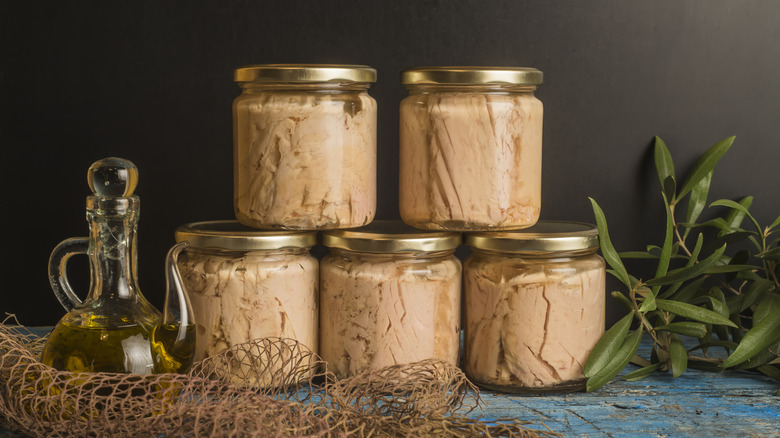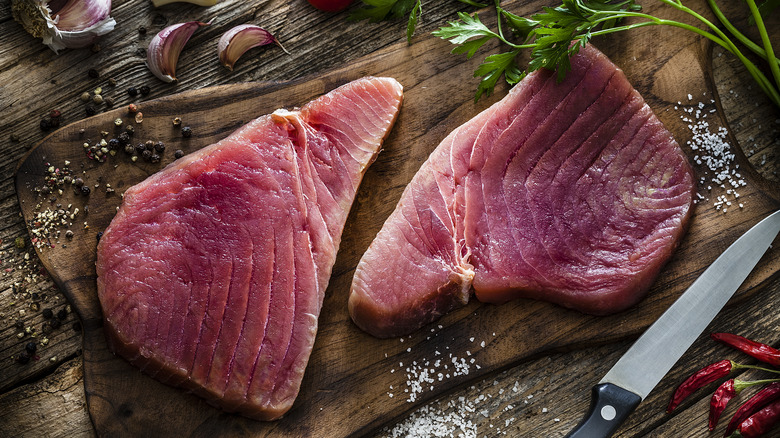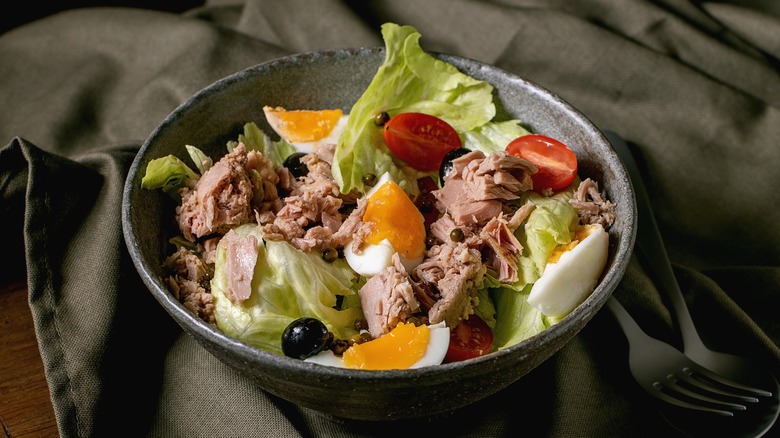When Making Your Own Canned Tuna, What's The Best Variety To Use?
Canned tuna is one of the most handy pantry staples to have around. It can be made into sandwiches, stirred into cold or warm pasta dishes, and even eaten straight out of the can if one is so inclined. Canning tuna also happens to be an easy kitchen project to carry out on a weekend. Preserving animal products need not be intimidating, and homemade canned tuna is an easy way to get started in the world of home preservation.
However, which tuna type should one use for canning? There are several tuna varieties on the market, and different species lend themselves to different culinary applications. While skipjack tuna is the most common variety used for canning other varieties tend to come in bigger chunks, therefore providing a more substantial eating experience. And out of all those other varieties, albacore tuna ticks the boxes of good eating, affordability, and sustainability. Albacore is one of the milder-tasting tuna varieties, making it a great choice for home preserving so that you can easily customize added flavors.
As for sustainability, according to the International Union for Conservation of Nature and Natural Resources, the albacore tuna is no longer "near-threatened" and has changed its status to "least concern". While that is definitely good news, it is still advisable to seek out tuna that has been labeled with "pole-caught", "troll-caught", and "pole-and-line" to ensure that you are using responsibly sourced seafood.
How to can your own tuna
Much of commercial canned tuna is pre-cooked by steaming it, as this is likely the most cost-effective way. When it is packed into cans or jars with other ingredients— olive oil, chili flakes, thyme, —it gets heated up again, and this is when flavor is usually worked into the fish.
So how does one make canned tuna at home? Aside from the albacore fillets themselves, it actually doesn't require much beyond a few ingredients and tools that are likely already in your kitchen, along with patience. The added bonus of preserving tuna yourself is that the flavor can be enhanced every step of the way, especially by using the confit technique.
Here's how: First of all, liberally salt about two pounds of albacore filets that have been trimmed into two-inch chunks. While the filets sit, heat up three cups of oil along with preferred herbs and spices to a bare simmer, or use a thermometer and make sure the temperature of the oil hits 165°F. Maintain this heat for at least 20 minutes, then lower the temperature to 150°F. Slide in the albacore filets, making sure it is fully submerged in the oil. Turn off the heat and cover the pot. Let the filets sit in the oil for about 45 minutes for the flavors to infuse all the way through.
How to use your homemade canned tuna
After the fish has steeped, remove it from the oil and gently pack it into sterilized glass jars. Strain the leftover infused oil and pour the strained oil over the fish, again, making sure to submerge the pieces completely. Cap the jars. It'll last for around two weeks in the fridge—make sure you use clean and dry utensils when taking pieces of fish out of the jars so that it will last as long as possible.
While there are many ways to use canned tuna, the best way to showcase these precious filets of homemade canned albacore is by doing as little to it as possible. Flake it over a Niçoise salad, spoon it over crackers, or, as suggested at the start of this article, simply eat it as is and enjoy a truly luxurious snack. If your local market is out of albacore, try yellowfin tuna, or other firm-fleshed fish like halibut and swordfish.
Don't forget about the leftover infused oil. Use it as you would other infused oils — drizzle it over salads, pasta, and toast, or even to fry eggs. Remember to use an oil that you enjoy the flavor of, like olive oil, or a neutral oil that can carry the flavors of additional herbs and spices.


